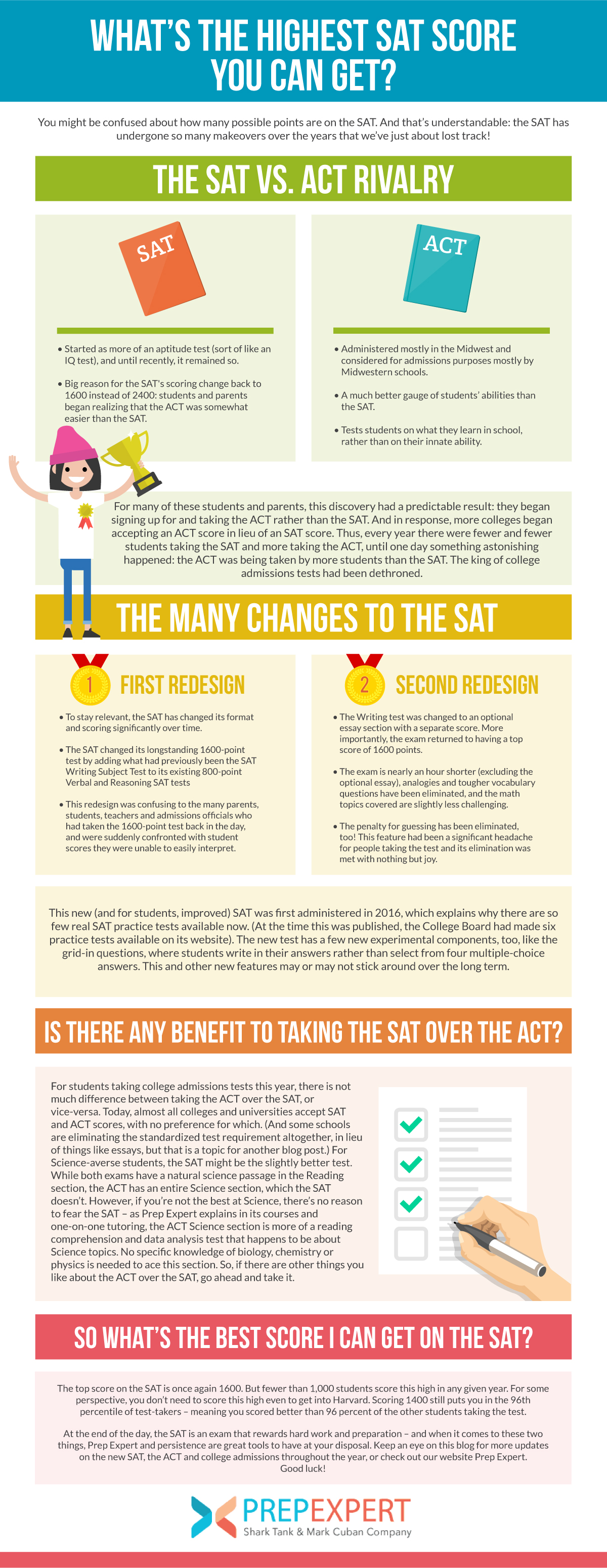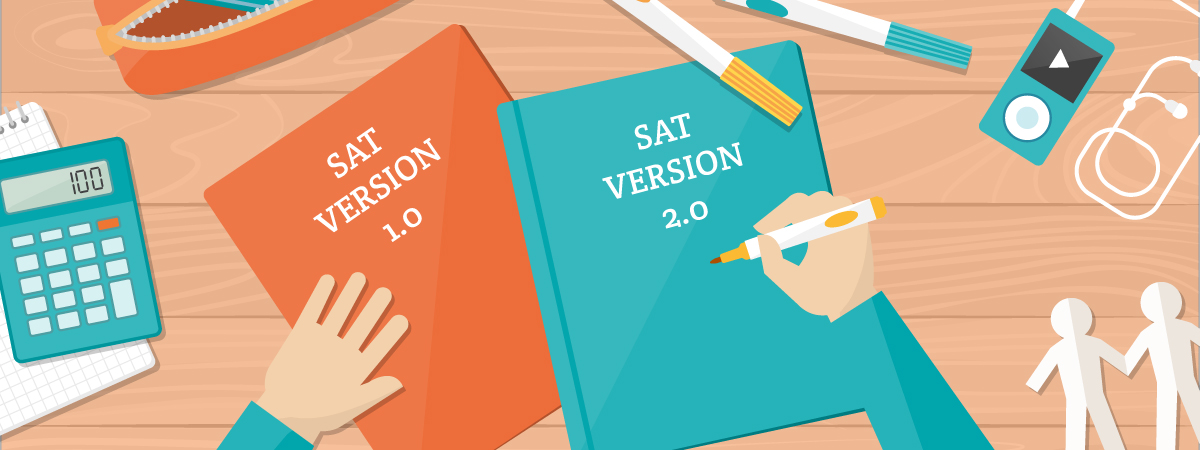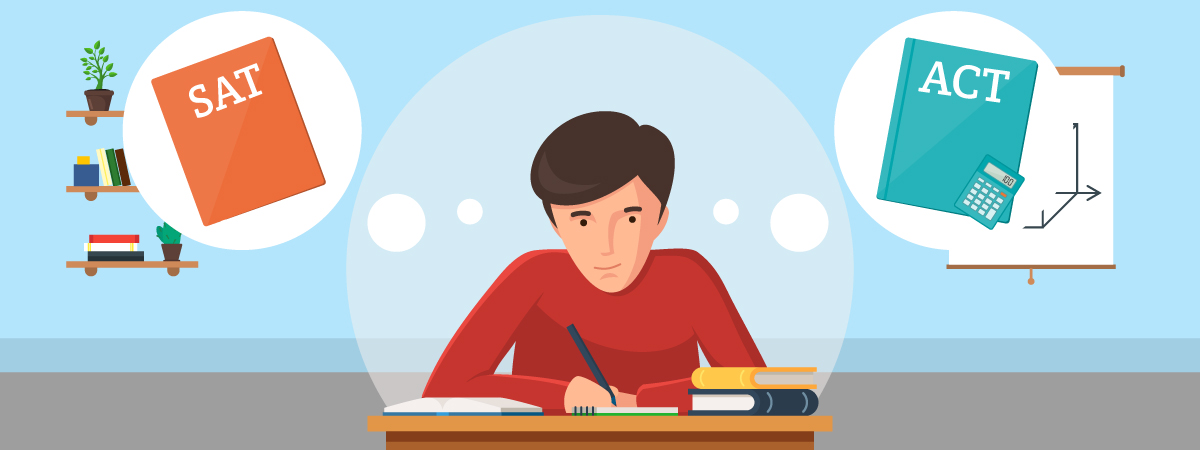What’s The Highest SAT Score You Can Get?
Originally, the SAT was scored out of 1600 possible points up until the mid-2000s, where it was bumped up to 2400 points. However, the SAT recently reverted back to its original scoring.
Part of the reason for this stems from the College Board constantly updating the test to keep it accurate for the rigor of college curriculums. But the SAT has also undergone changes to remain in business with a tough, gradually rising competitor: the ACT.
The current, updated SAT is scored out of 1600 points, meaning a perfect score of 1600 is the highest score one can achieve. Let’s discuss why in this article.
[sat_one]
If you’re looking to try and hit that perfect 1600, then enrolling in one of our SAT prep courses will definitely help you out.

The SAT Vs. ACT Rivalry
For years, the SAT was the undisputed king of college admissions tests, but the ACT gained ground over time.
The ACT was originally a puny also-ran, administered mostly in the Midwest and considered for admissions purposes mostly by Midwestern schools. However, over the years, students and colleges began to realize something about the ACT.
As a test of mastery of the subjects covered in high school classes – English, Mathematics, Reading, and Science – the ACT was a much better gauge of students’ abilities than the SAT. The SAT had started as more of an aptitude test (sort of like an IQ test), and until recently, it remained so.
Another big reason for the SAT’s scoring change back to 1600 instead of 2400: students and parents began realizing that the ACT was somewhat easier than the SAT. This makes sense, as the ACT tests students on what they learn in school, rather than on their innate ability.
At the time, the ACT also lacked what were many of the SAT’s more punishing features – there were no analogies, less challenging vocabulary and math problems, and a calculator was allowed throughout the Mathematics section. Perhaps most significantly, there was no penalty for guessing on questions.
For many of these students and parents, this discovery had a predictable result: they began signing up for and taking the ACT rather than the SAT. And in response, more colleges began accepting an ACT score in lieu of an SAT score.
Thus, every year there were fewer and fewer students taking the SAT and more taking the ACT, until one day something astonishing happened: the ACT was being taken by more students than the SAT. The king of college admissions tests had been dethroned.

The Many Changes To The SAT
To stay relevant, the SAT has changed its format and scoring significantly over time.
Students who are in high school now likely remember upperclassmen from a couple of years ago taking an SAT that was scored out of 2400 rather than 1600 points. This is because just a few years ago, the SAT changed its longstanding 1600-point test by adding what had previously been the SAT Writing Subject Test to its existing 800-point Verbal and Reasoning SAT tests.
This redesign was confusing to the many parents, students, teachers and admissions officials who had taken the 1600-point test back in the day, and was suddenly confronted with student scores they were unable to easily interpret. As a result, adjusting to the new test caused unnecessary grief to students, parents, and educators.
But they didn’t have this problem for long. To stay competitive with the ACT and reclaim its mantle as the number-one college admissions test, the SAT underwent yet another makeover. The Writing test was changed to an optional essay section with a separate score.
More importantly, the exam returned to having a top score of 1600 points. But this was far from its only change: after its extensive revisions, the SAT suddenly looked a lot like the ACT. Don’t assume that this closer ACT look was done by accident.
Students today will take an SAT that is in many ways a facsimile of the ACT, which is scored out of 36 points. The exam is nearly an hour shorter (excluding the optional essay), analogies and tougher vocabulary questions have been eliminated, and the math topics covered are slightly less challenging.
Oh, yeah – and the penalty for guessing has been eliminated, too! This feature had been a significant headache for people taking the test and its elimination was met with nothing but joy. Nothing like market competition to make things better for the consumer – in this case, you, the student.
This new (and for students, improved) SAT was first administered in 2016, which explains why there are so few real SAT practice tests available now. (At the time this was published, the College Board had made six practice tests available on its website).
The new test has a few new experimental components, too, like the grid-in questions, where students write in their answers rather than select from four multiple-choice answers. This and other new features may or may not stick around over the long term.
As it has for so many years, the SAT will continue to evolve, and as it works out its kinks after this most recent change, many students will continue to opt for the relative predictability of the ACT.

Is There Any Benefit To Taking The SAT Over The ACT?
For students taking college admissions tests this year, there is not much difference between taking the ACT over the SAT, or vice-versa.
Today, almost all colleges and universities accept SAT and ACT scores, with no preference for which. (And some schools are eliminating the standardized test requirement altogether, in lieu of things like essays, but that is a topic for another blog post.)
For Science-averse students, the SAT might be a slightly better test. While both exams have a natural science passage in the Reading section, the ACT has an entire Science section, which the SAT doesn’t.
However, if you’re not the best at Science, there’s no reason to fear the SAT – as Prep Expert explains in its courses and one-on-one tutoring, the ACT Science section is more of a reading comprehension and data analysis test that happens to be about Science topics.
No specific knowledge of biology, chemistry or physics is needed to ace this section. So, if there are other things you like about the ACT over the SAT, go ahead and take it.
[sat_two]

So What’s The Best Score I Can Get On The SAT?
The top score on the SAT is once again 1600. But fewer than 1,000 students score this high in any given year.
For some perspective, you don’t need to score this high even to get into Harvard. Scoring 1400 still puts you in the 96th percentile of test-takers – meaning you scored better than 96 percent of the other students taking the test.
In almost every SAT prep class I teach, I get the same question from students: what’s a good SAT score? And I give the same answer every time: it depends! A good SAT score is the score that gets you into the college you want to attend.
And so for every student, the answer to this question will be different. The first thing you should do is make a list of colleges you might like to attend. Then you’ll want to check each college’s website to find their SAT score band, which shows what score the 25th, 50th and 75th percentiles of accepted applicants received. (Applicants in the 25th percentile had a score higher than 25 percent of other applicants, and so forth.)
Generally, the better your GPA, the lower SAT score you can get away with, although to be competitive for admission at most colleges you’ll want a GPA and SAT score around the 50th percentile for that school. With scores closer to the 75th percentile, you’ll have an increasingly better shot at admission – although remember, nothing is a guarantee.
You can then rank your colleges into safeties, competitive and reaches – safeties being the schools where your scores are closer to the 75th percentile, competitive where you’re right around the middle, and reaches where you’re closer to the 25th percentile.
You should have at least three or four schools in each category to be confident you’ll achieve admission to at least one college. Don’t skimp on safeties or reaches – you never know what will happen in the game of college admissions!
It’s also important that you remember your score is not who you are. It’s not a gauge of your worth or success as a person. And it’s also something that you can work on. Almost all colleges will accept your combined highest score – that is, your highest Verbal and highest Reasoning scores – and you can take the exam as many times as you like.
So, if you have a bad test day or if you need to do more studying, know that there’s always another day. This isn’t to say you should gird yourself for a never-ending battle for 1600. You should also be realistic and aim for a score you can feasibly achieve and not push yourself too hard.
Your family life and high school classes shouldn’t suffer because of exam prep. Remember these things are important to your success, well-being, and college admissions chances, too. If you do want to improve your SAT score, Prep Expert can certainly help.
We offer SAT prep courses with top instructors around the year, in cities across the country and online. And if you’d like personalized help, you can also work with our top instructors one-on-one, also in person and online. At the end of the day, the SAT is an exam that rewards hard work and preparation – and when it comes to these two things, Prep Expert and persistence are great tools to have at your disposal.
[sat_three]
For more test strategy, college admissions, and scholarship application tips sign up for our FREE class happening right now!
Written by Dr. Shaan Patel MD MBA
Prep Expert Founder & CEO
Shark Tank Winner, Perfect SAT Scorer, Dermatologist, & #1 Bestselling AuthorMore from Dr. Shaan Patel MD MBA

How to Get Into Stanford: Breaking Down Stanford Admission Requirements in 2024
Applying to college is overwhelming no matter what schools are on your list, but you might find yourself sweating a…

Why DEI is Destroying Meritocracy and How MEI Can Save Us
In recent years, Diversity, Equity, and Inclusion (DEI) initiatives have become a cornerstone of many corporate and educational policies. While…

Should I Take an SAT Prep Course?
If you’re getting ready to take the SAT soon, you might be wondering whether or not you should enroll in…